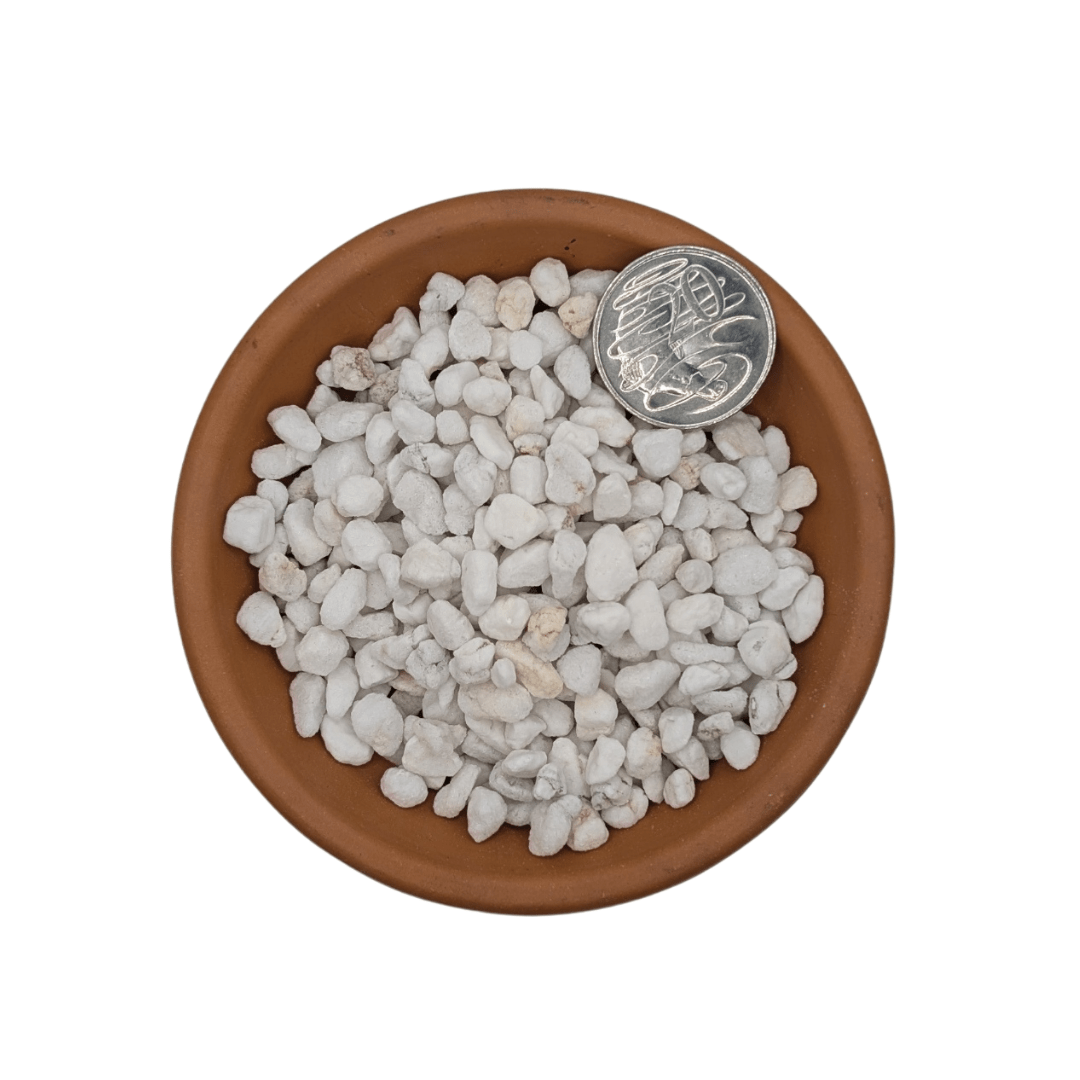Unlock the power of optimal aeration and moisture balance with Super Coarse Perlite. This premium-grade, expanded volcanic rock is specifically crafted for plants that demand exceptional drainage and root oxygenation, such as aroids, orchids, and bromeliads.
When heated above 850°C, the natural rock expands into lightweight, porous granules that promote healthy root development and prevent common issues like root rot. A must-have additive for custom potting mixes, especially for exotic and epiphytic plants.
Features
Superior Aeration: Enhances air circulation around roots to encourage strong, healthy growth
Optimal Moisture Balance: Retains essential water without waterlogging the mix
Super Coarse Particle Size: Perfect for plants requiring larger air pockets like orchids, bromeliads, and aroids
Lightweight and Inert: Will not compact, decompose or alter your soil's nutrient balance
Versatile Mixing Ratio: Easily blends with coir, peat, bark or other substrates in a 1:1 or custom ratio
Why You Should Buy
Super Coarse Perlite is the perfect upgrade for your premium potting mixes. Whether you're growing rare aroids or vibrant orchids, this media provides unmatched air-to-water ratio to support the unique needs of tropical and epiphytic plants. Its structure encourages robust root systems while preventing soggy, dense soils that can suffocate roots. Lightweight and sterile, it's suitable for both hobbyists and commercial growers who prioritize plant health and long-term vitality.
How to Use
Measure your base mix and incorporate perlite at a 1:1 ratio for maximum aeration. Mix thoroughly to ensure uniform distribution. Ideal for repotting or upgrading existing blends for exotic plant care.
FAQs
What is “Super Coarse” perlite and why should I use it for aroids, orchids, and bromeliads?
Super coarse perlite is expanded volcanic rock with big, irregular particles that create chunky air pockets—exactly what epiphytic and semi-epiphytic plants want for oxygen at the roots and fast drainage (less rot, stronger roots). It’s inert, lightweight, and doesn’t decompose, so mixes stay airy longer.
What’s the particle size of super coarse perlite?
This product lists a super-coarse grade with typical particles around 5–10 mm. That “chunky” size is a sweet spot for opening up dense mixes for aroids, orchids, and bromeliads.
How much perlite should I add to my aroid mix?
Common recipes use roughly 20–40% chunky perlite alongside bark and coco/peat. Start at 1:1 with your base mix if you need maximum aeration, then dial back if your plant prefers a bit more moisture.
What about orchids—how do I use super coarse perlite there?
Blend coarse perlite with orchid bark/charcoal to keep the medium “open” long-term. Many growers add a substantial chunk of coarse perlite for phals, oncidiums, and similar types to prevent compaction between repots.
And bromeliads—does super coarse perlite help?
Yes. Bromeliads hate soggy roots. Adding chunky perlite to a barky/sandy mix boosts drainage and airflow, cutting down on rot risk.
Will this perlite float to the top when I water?
Some floating is normal at first. Pre-moisten it and mix thoroughly; watering gently helps it settle and stay distributed.
Do I need to rinse perlite before using it?
It’s smart to give it a quick rinse to knock down dust (and pre-moisten it so it doesn’t float as much). Handle outdoors or wear a basic dust mask if it’s very dry.
Is perlite dust dangerous?
Horticultural perlite is generally classed as a “nuisance dust.” It can irritate eyes/throat and is best handled damp or with a simple mask—especially if you have respiratory sensitivities.
Is super coarse perlite pH-neutral and does it affect nutrients?
Perlite is inert and doesn’t contribute nutrients or significantly change pH—it mainly boosts structure and airflow so roots can access water and nutrients more effectively.
Can I reuse perlite? How do I sterilize it?
Yes. Rinse thoroughly to remove old organics. To sterilize, you can bake damp perlite in the oven (low heat, short duration) or soak in a mild peroxide solution, then rinse again.)
Does perlite break down or compact over time?
It doesn’t decompose like bark, but granules can abrade into smaller pieces after years of mixing and watering. Topping up with fresh perlite at repot time restores the airiness.
Perlite vs pumice—what’s better for my plants?
Both add aeration. Perlite is lighter and cheaper; pumice is heavier (less float) and can add trace minerals. For indoor mixes where pot weight matters, perlite is usually the go-to; for windy balconies or top-dressing, pumice’s extra heft can help.
Perlite vs vermiculite—what’s the difference?
Perlite = aeration & drainage. Vermiculite = moisture retention. For aroids/orchids/bromeliads that dislike wet feet, lean perlite-heavy; add vermiculite only if you need extra moisture in very dry conditions.
Can I use super coarse perlite for propagation?
Yep. Perlite propagation works great for many cuttings—rinse first to remove dust, then keep evenly moist. Chunky grade supports larger stems; finer grades cradle small nodes.
Is super coarse perlite safe around pets?
Perlite is considered inert. Small accidental nibbles are usually not an issue, but eating a lot could upset a pet’s stomach because it’s absorbent—so keep bags and mixes out of reach.
Can I use super coarse perlite in semi-hydro or hydroponics?
Yes. Because it’s inert and doesn’t break down quickly, perlite is used in hydro/semi-hydro systems and wick setups. Rinse first and expect a little initial float.
What ratios do you recommend for common aroids?
A good starting point:
• Monstera/Philodendron: ~30–40% coarse perlite + bark + coco/peat.
• Anthurium (terrestrial types): 20–30% coarse perlite in a chunky, airy base.
Adjust based on your home’s humidity and watering style.
Does perlite help with fungus gnats?
Indirectly. By speeding drainage and reducing soggy pockets, perlite makes your mix less attractive to gnat larvae. Still pair with good watering habits and gnat controls if they’re already present.
How do I keep the mix evenly chunky over time?
When you repot, stir the mix to break up any settling and add a fresh handful of chunky perlite to re-open air channels—especially if you bottom-water or your pots are tall.
What bag sizes are available and where do you ship from?
Currently listed sizes are 5 L, 25 L and 100 L, with local pickup in Bellambi, NSW (usually ready in 24 hours).
Any quick mix templates to copy/paste?
• “Ultra-airy Aroid”: 1 part bark : 1 part chunky perlite : 1 part coco/peat.
• “Orchid Refresh”: 2 parts bark : 1 part chunky perlite : optional charcoal.
• “Bromeliad Base”: barky mix + a big handful of chunky perlite for each pot to keep roots dry-but-breathing.
Will adding perlite change how often I water?
Yes—your pots will dry faster because the mix is more porous. Expect to water a bit more frequently, but with fewer root-rot headaches.
Can I top-dress with perlite, or should it be mixed in?
Mix it through the substrate for best results. A pure perlite top layer can blow or float away and doesn’t aerate the root zone as effectively as mixing.
Any tips to reduce mess and dust indoors?
Pre-wet perlite in a tub, scoop gently (don’t pour from height), and mix outdoors or in a sink. A simple dust mask is helpful for dry batches.
What else pairs well with super coarse perlite for a premium aroid/orchid mix?
Orchid bark, coco coir, and a small amount of high-quality organic matter (like worm castings) give you a chunky, breathable mix with just enough moisture holding.
Is it recyclable or reusable from an environmental perspective?
Perlite is a mined mineral that can be reused multiple times in potting mixes. Reuse by rinsing/sterilizing; discard heavily contaminated batches.
Anything to watch out for with very fine roots or seedlings?
For very fine roots or seed starting, finer grades can hold more moisture and cradle tiny roots better; the super-coarse grade is best for chunky mixes and established plants.
Can I combine perlite with LECA in semi-hydro?
You can. Perlite adds wicking and fills voids; LECA adds weight and structure. Rinse both well and test your watering cadence because media will dry faster than soil.
Does perlite add nutrients or trace elements?
Not meaningfully. Think of it as structural—use your usual fertiliser program for nutrition.
Best quick fix if my mix is staying wet too long?
Stir in more chunky perlite (10–20% by volume), switch to a pot with more drainage, and water more thoroughly but less often.


